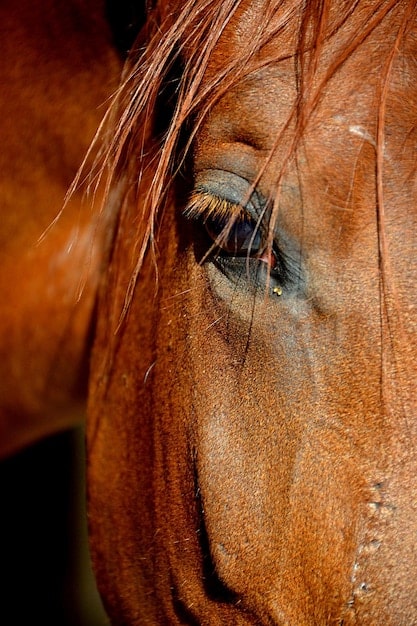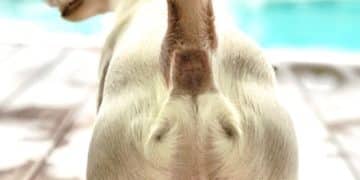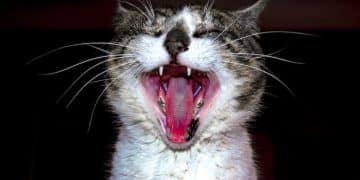Understanding Equine Body Language: Key Postures & Signals

Understanding equine body language involves interpreting key postures that signal stress or relaxation, enabling better communication and care for horses.
Understanding what your horse is trying to tell you through its body language is crucial for building a strong, trusting relationship. Let’s dive into understanding equine body language: 3 key postures that signal stress or relaxation.
Decoding the Language of Horses: An Introduction
Horses, being prey animals, rely heavily on non-verbal communication. Observing their posture, facial expressions, and movements can reveal a wealth of information about their emotional state and intentions.
By learning to interpret these signals, you can better understand your horse’s needs, prevent potential problems, and foster a deeper connection.

The Relaxed Horse: Key Signs of Contentment
A relaxed horse exhibits several distinct physical characteristics. These signs indicate that the horse feels safe, comfortable, and at ease in its environment.
Head and Neck Position
A horse in a relaxed state typically carries its head and neck in a lowered position. This posture reduces tension in the muscles and allows the horse to conserve energy.
Body Posture
A relaxed horse often stands with a hind leg cocked, shifting its weight comfortably. The back muscles are relaxed, and the overall posture appears loose and unforced.
- Soft Eyes: Relaxed horses have soft, gentle eyes with no tension around them. The gaze is unfocused and calm.
- Loose Jaw: A relaxed jaw may be slightly open or drooping, often accompanied by gentle chewing motions even without food.
- Relaxed Tail: The tail hangs loosely and swings gently. There’s no tension or clamping down of the tail.
Recognizing these signs of relaxation allows you to confirm that your horse is comfortable and content. This knowledge is vital for creating a positive training environment and building trust.
Stress Signals: Recognizing Discomfort and Anxiety
When a horse is stressed or anxious, it displays a variety of physical and behavioral cues. Identifying these signals early on can help you address the underlying cause and prevent escalation.
Many begin with subtle signals, escalating if the source of stress isn’t addressed.

Elevated Head and Tense Muscles
A stressed horse often elevates its head and neck, creating a tense posture. The muscles in the neck and shoulders become tightened and rigid.
Wide Eyes and Tense Mouth
Stressed horses often have wide, alert eyes, sometimes showing the whites of their eyes (sclera). The mouth may be tightly closed or exhibit tension around the lips.
- Pinned Ears: This posture indicates irritation, aggression, or fear. The horse may be trying to ward off a perceived threat.
- Pawing or Stomping: Pawing at the ground or stomping a foot can be a sign of frustration, anxiety, or an attempt to displace pent-up energy.
- Increased Respiration: Rapid breathing or flared nostrils indicate that the horse’s body is in a heightened state of arousal, preparing for a potential fight-or-flight response.
Understanding these stress signals enables you to intervene before the horse becomes overwhelmed. Addressing the source of the stress and providing reassurance can prevent the development of more serious behavioral problems.
The Tail as a Thermometer: Understanding Tail Signals
The tail is not just for swatting flies; it’s a significant indicator of mood and intention. Paying attention to the tail can provide valuable insights into a horse’s emotional state.
A neutral tail carriage is relaxed and loose. Changes from this neutral position can indicate a shift in the horse’s emotional state.
Swishing or Wringing the Tail
Excessive tail swishing, especially when not accompanied by flies, suggests irritation or annoyance. Wringing the tail tightly can indicate pain or intense stress.
Clamping the Tail Down
A horse that clamps its tail tightly against its body usually signifies fear, anxiety, or submission. This posture is often seen in horses that feel threatened or uneasy.
- Elevated Tail: An elevated tail can indicate excitement, playfulness, or a heightened state of alertness. However, it can also be a sign of dominance or aggression in some situations.
- Tail Held to the Side: Holding the tail to one side may indicate discomfort or pain in the hindquarters. It’s crucial to rule out any potential physical issues.
Considering the context in which the tail signals are displayed is key to accurate interpretation. Combining tail observations with other body language cues will help you develop a comprehensive understanding of your horse’s emotions.
Facial Expressions: The Window to the Horse’s Soul
The horse’s face is remarkably expressive, conveying a wide range of emotions. Paying close attention to the eyes, ears, and mouth can reveal a wealth of information about its internal state.
Subtle twitches of facial muscles can provide early indicators of a horse’s mood and intent.
The Eyes: Indicators of Alertness and Anxiety
Wide, alert eyes indicate heightened awareness and potential anxiety. Soft, relaxed eyes communicate contentment and trust.
The Mouth: Revealing Tension and Relaxation
A tight, tense mouth suggests stress or discomfort. A loose, relaxed mouth (sometimes slightly open) indicates a calm and peaceful state.
- Ears Forward: Ears pointing forward generally indicate interest, attentiveness, or curiosity. The horse is focused on something in its environment.
- Ears Turned to the Side: Ears positioned to the side usually suggest relaxation or disinterest. The horse may be resting or not actively engaged in its surroundings.
Understanding the nuances of facial expressions empowers you to connect with your horse on a deeper level. It allows for proactive response to their needs and builds a relationship founded on empathy and respect.
The Importance of Context: Putting it All Together
Interpreting equine body language effectively requires careful attention to context. A single posture or expression should not be analyzed in isolation; instead, consider the surrounding environment, the horse’s history, and its relationship with other individuals.
Consider the situation, the presence of other horses or people, and any recent events that may be influencing the horse’s behavior.
Environmental Factors
Is the horse in a familiar environment or a new and potentially stressful situation? Loud noises, sudden movements, or unfamiliar objects can all trigger stress responses.
Social Dynamics
How does the horse interact with other horses or people in its environment? Observing social interactions can reveal dominance hierarchies, bonding relationships, and potential sources of conflict.
- Previous Experiences: A horse’s past experiences can significantly influence its current behavior. A horse with a history of negative interactions may be more prone to anxiety or fear.
- Consistency: Maintaining consistency in your interactions with your horse can help build trust and reduce anxiety. Predictable routines and clear communication are essential.
By considering the context, you can develop a deeper and more accurate understanding of your horse’s communication. This will allow you to respond appropriately to its needs and foster a stronger, more harmonious partnership.
| Key Point | Brief Description |
|---|---|
| 🐴 Relaxed Posture | Lowered head, soft eyes, loose tail indicate comfort. |
| 😨 Stress Signals | Elevated head, pinned ears, rapid breathing denote anxiety. |
| tail movements | Clamping indicates fear, swishing can mean irritation. |
| 👁️ Facial Expressions | Eyes, ears, and mouth reveal emotions like tension or calm. |
Frequently Asked Questions
▼
Understanding equine body language enhances communication, fosters trust, and improves safety during interaction by helping you recognize their needs and emotional state.
▼
Key signs of a relaxed horse include a lowered head, soft eyes, a loose jaw, and a relaxed tail. The horse may also stand with one hind leg cocked.
▼
Signs of stress in a horse include an elevated head, tense muscles, wide eyes, pinned ears, pawing at the ground, and increased respiration. A horse that clamps its tail may also be experiencing stress.
▼
Tail swishing often indicates irritation or annoyance. However, it’s essential to rule out the presence of flies or other insects. Excessive tail swishing may signal discomfort.
▼
Improve by observing horses in various situations, learning from experienced horse handlers, and considering the context of each interaction. Consistency and patience are key.
Conclusion
By mastering the art of understanding equine body language, you will cultivate a deeper connection with your horse, ensuring a relationship built on mutual respect, understanding, and trust, leading to a more harmonious partnership.




